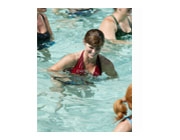Pilates Principles
by Carol Argo (Fitness Professional)
 Tips for Teaching Pilates Water Walking - By Carol Argo
Tips for Teaching Pilates Water Walking - By Carol Argo
Pilates concepts can be effectively integrated into a shallow water walking program, according to Carol Argo, AEA 2002 Global Award Aquatic Fitness Professional, Los Angeles-based STOTT PILATES® Certified Matwork Instructor and IDEA member since 1988. Your clients will benefit by developing a stronger core while improving overall strength and flexibility. Posture and body awareness are enhanced through concentration and focus. The flowing movements performed against the water’s resistance provide a challenging workout, yet are easily modified for different fitness levels.
To use Pilates concepts in water walking, it’s helpful to have a background in Pilates. However, you can also utilize the following Pilates principles to transform an ordinary water walking program into an extraordinary Pilates style format.
Pilates Principles
1. Breathing. Focus on expanding the ribcage while inhaling and deepening the abdominal contraction during the exhalation. Inhale through the nose and exhale through the mouth. Synchronize the rhythm of walking with the breath. Inhale when extremities move away from the centerline of the body. Exhale during adduction when extremities return back to the centerline.
2. Pelvic and Rib Cage Stabilization. Maintain neutral spine by aligning ASIS (Anterior Superior Illiac Spine) and pubic bone on same plane. Avoid “popping the ribs up” or an anterior pelvic tilt. Likewise, avoid tucking the tailbone under or a posterior pelvic tilt. Maintain the same distance between the lower rib and upper pelvis.
3. Scapular Stabilization. Although the scapulae move with the arms, a sense of stability, not rigidity, should always be maintained. Keep the feeling of gently sliding the scapulae down the back and in toward the spine in a “V”. A sense of width should be maintained across the collar bones and back of the shoulder girdle.
4. Centering. All movement begins from the body’s center and moves outward. Move from the inside out. Blossom and radiate energy outward while moving the extremities.
5. Fluidity. Movements are fluid and graceful, not static and isolated.
6. Integrated Isolation. Each exercise utilizes muscles for stabilization and different muscles for mobilization. The entire body is engaged.
Review Pilates principles and moves you plan to use before going to the pool. This will give you a feeling for the exercises before entering the water. It’s important to practice out of the water in order to effectively demonstrate to your students. When teaching the workout, make sure to start with a 5- to 10-minute brisk total body warm-up.
Sample Moves
1. Forward Stride. Emphasize heel to ball and full range of motion. Keep feet close to ground. Use the following upper-body movements/positions:
a. Alternate arms while rotating palms from front to back (sagittal plane).
b. Sweep arms across body with thumbs up (transverse plane).
c. Position arms behind body, shoulders externally rotated, no movement.
d. Rotate shoulders-bilateral movement (transverse plane).
e. Touch arms to sides of body, no movement.
f. Abduct arms with shoulders stabilized and thumbs up, no movement.
2. Walk backward with legs wide apart. Rotate torso and reach one arm toward opposite leg. Maintain long levers.
3. Step and bring legs together on a diagonal creating a zig-zag pattern. The arms and legs abduct and adduct. Touch the sides of body and abduct arms to just below shoulders.
Teaching Cues
Try some of these cues to help clients understand the correct alignment:
Lift through the crown of the head.
Lengthen the back of the neck.
Pull the abs in and up without movement in the rib cage and pelvis.
Zip up the front and down the back (Abs in and up, shoulder blades down).
You have a “headlight” on your pelvis. Keep the headlight shining straight ahead.
|
|
|









 Tips for Teaching Pilates Water Walking - By Carol Argo
Tips for Teaching Pilates Water Walking - By Carol Argo